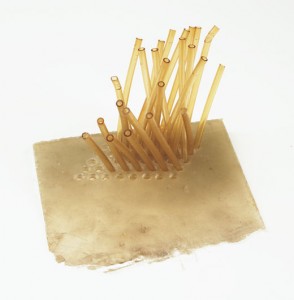
Eva Hesse, "Studiowork," 1968. Courtesy of University of California, Berkeley Art Museum & Pacific Film Archive. Photograph: Abby Robinson/Courtesy of the Fruitmarket Gallery, Edinburgh
Sometimes the most interesting thing about an artist is the disparity between their work and the established perception of it. Eva Hesse, the late German-American sculptor of ratty latex and dog-eared fiberglass, has suffered from what Nabokov called “dotting every i with the author’s head.” Her short career (she died from a brain tumor in 1970 after only about ten years’ work) and painful life (her mother’s suicide and her father’s death not long after) have been allowed to overshadow readings of her work, letting the natural disintegration of fragile materials stand as literal equivalents for her own physical demise. Of course, this conflation of life and work is something that especially dogs the work of female artists (Artemesia Gentileschi, Virginia Woolf, Britney Spears), but in the case of Hesse’s body of work – which consists of light-heartedly erotic objects of a maudlin wit – it’s particularly galling.
A new show of previously-unseen work – a real coup for Hesse fans, since much of her best-known work is now too fragile to travel – at the Fruitmarket Gallery in Edinburgh, entitled Studiowork, brings to light aspects of her work that illustrate the artist’s fervent assertion of its “absurdity.” It’s not laugh-out-loud hilarious, but the false-start, experimental nature of much of the work here reveals a working process not dissimilar to that of a stand-up comedian worrying over combinations of ridiculous circumstances. And absurd combinations of things – visual equivalents for a rabbi walking into a bar, or Michael Jackson and Himmler meeting at the pearly gates – are what characterize Hesse’s contribution to the evolution of the non-metaphorical sculptural object after the 1960s.
If that last sentence had you nodding off at your keyboard, and you’ve just woken up to a screen filled with the letter ‘r’ and a river of saliva out of the corner of your mouth, it’s because Hesse’s work and the tradition it derives from (that of minimalist ‘specific objects’ after the 1960s) is visual, not verbal. Translating what is, when it’s successful (as in Richard Serra’s great arcing slabs of steel, or Donald Judd’s austere parade of aluminum boxes), a profound awareness of one’s own body in relation to the space of the gallery into the grinding rhetoric of art theory is missing the point. Minimalism is the closest thing contemporary art has come to an art of the sublime. Hesse’s work, though – sometimes bracketed, with spectacular joylessness, “post-minimalism” – plays the language of the sublime against itself, using materials that willfully accrue unsettling simile.
A small number of larger works – the familiar pendulous black orbs (familiar from her work, I mean; not familiar from anywhere else) in fishermen’s nets, a sheet of cheesecloth dipped in ochre latex – surround vitrines with small-scale sculptural experiments. It’s like a lab in a horror film. A square of latex sprouts a little colony of plastic tubes that grope blindly for the light. A gooey-looking orange bucket, about the size of a teacup, grows a snaky wick, in a twofer of grimy science and alien sexuality. Uneasily physical though a lot of Hesse’s work is (the semi-translucent shells and casings can’t help but recall preserved human skin, and there are enough genital double-entendres to entertain a cluster of Freudians for at least an hour and a half), what always works best is when an odd couple of materials are forcibly introduced and are allowed to do what gravity bids them—visual art’s mismatched buddy comedy. Hesse’s sculptures reveal not only a perfect pitch for materials, but a finely-honed comic sensibility that makes their presence in the midst of a comedy festival ultimately, and unexpectedly, fitting.
![dscn5060 John McCracken at Inverleith House, Edinburgh [photo: Ben Street]](https://magazine.art21.org/wp-content/uploads/2009/08/dscn5060-300x225.jpg)
John McCracken at Inverleith House, Edinburgh. Photo: Ben Street.
Across town at Inverleith House in the heart of the Royal Botanic Gardens, the debut solo exhibition by Californian minimalist John McCracken is straight man to Hesse’s knockabout clown. Two floors of sleek, monochrome monoliths – the ground floor all black, the first floor in rich, summery yellows, blues and reds – provide an object lesson in how to carry a room. Meticulously buffed and polished for maximum reflection, the black objects appear and disappear, both flat and glossy like a body of water and assertively physical like a forest of skyscrapers. The implied work in each object – each finished much as a surfboard is, with layers upon layers of glossy lacquer over a plywood base – gives each one the air of received attention and a kind of faux-casual power that can catch you unawares. Upstairs, two planks – one black, one yellow – lean at a slight angle to the wall, louche hangers-on at a boring party. Yet by linking the wall and the floor – the space for thought and the arena for action – McCracken opens up an unexpected area of experience. It’s hard not to see his work as the product of a baked mid-sixties mind, and the experience of his work engenders the same sense of wonder as a stoner examining a TV remote at close range: it’s here, it’s real, but, like, why? The artist’s sketches, displayed here, are accompanied by handwritten captions that suggest the artist was as awestruck and perplexed by his own inventions as the viewer can be. Underneath several pencil sketches of sculptural ideas, the artist writes, “Interesting idea: these are beings of another world transmitting themselves here through me.” He then goes on, with impeccable comic timing, “Don’t ask me why they’re here.”




Pingback: What’s Cookin at Art21: A Weekly Index | Art21 Blog